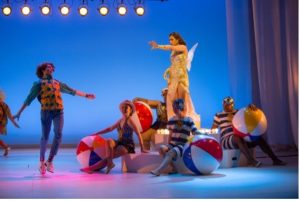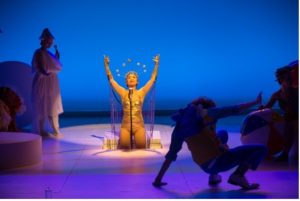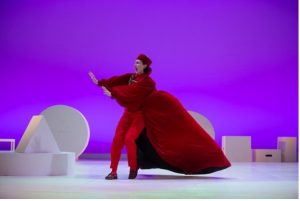Translating a play from one language to another is an act of funambulism — a blend of balance, precision, and grace. The task of the translator requires not only an understanding of both languages but also a cognizance of the cultural frameworks, historical backgrounds, and stylistic structures imbued and embedded within the text.
Translating for the theatre offers another essential creative balancing act; a theatrical text is meant to be embodied — performed. The translator must consider how the work will be translated onto the stage, and, conceivably, before a contemporary audience’s expectations, and sensibilities.
In late 2021 I began work on a new translation and production of Carlo Gozzi’s L’Augellino Belverde in collaboration with Enrico Picelli, a native speaker of the Venetian dialect. While still in a draft form, I directed a production for the Department of Theater at Rutgers University’s Mason Gross School of the Arts (See the photos).
It has been a method of mine as I work on a translation to test the work in performance as an important step in the process.
Translation is not transcription. A word for word conversion of a text would be an arid, deadly disservice to both the original and the potential audience. No translation can, with complete and unalloyed accuracy, reconstruct the original. Time and language will require a pliability and acuity in approach. Literary and dramatic forms will have to be adjusted or altered to fit the structures and demands of the new language and circumstances. Concepts, conventions, and contexts may have to be reframed. But translation is also not adaptation. The translator is not given creative license to revise, remodel, rewrite. Thus, the unique tightrope walk.
L’Augellino Belverde is by the 18th century Venetian playwright Carlo Gozzi. This play was a sequel to Gozzi’s highly successful 1761 play L’amore delle tre melarance (The Love of Three Oranges). Gozzi’s plays are not particularly well known in the United States. Though Gozzi’s body of work is quite varied, he is today best known by a good portion of the world for the operatic adaptions of his fantastical theatrical fables. These fables, like L’Augellino Belverde, were written in reaction to the bourgeois-focused proto-realism of Carlo Goldoni.
It was Gozzi’s stated intent to reinvigorate the commedia dell’arte tradition that he believed Goldoni to have forsworn. Gozzi’s L’Augellino Belverde stands out for its imaginative plot and vibrant characters (both stock and original), blending fairy-tale elements with satirical undertones to critique philosophical pretentions and human folly.
The task of translating such a text involves more than rendering words from Italian (and in much of this play, Venetian) to another language; it requires the translator to capture the essence of Gozzi’s wit, the vitality of his prose, the rhythm of his verse, and his vibrancy of characterization. This process often necessitates creative solutions to convey humor, wordplay, and cultural/historical references that may not have direct equivalents in English.
This requires collaboration with directors, actors, and dramaturges to ensure that the translation not only remains true to Gozzi’s original vision, but also resonates with modern theatergoers.
In the few other translations of the play into English, it is titled, The Green Bird. It was obvious that this not the full meaning of the title. The Little Green Birdie is not only a closer rendering, but better reflects the “childlike” quality and “ridiculous character” that Gozzi explicitly states in the preface as the point of the title.
An additional element that was not reflected in other extant English translations we found to be essential to Gozzi’s dramatic structure. Passages of the play, in accordance with long-established commedia practice, were improvised (specifically the role of Truffaldino in its entirety, large portions of Tartaglia’s dialogue, and some of the Brighella and Smeraldina’s “lines”). The characters’ dialogue is written by Gozzi in the third person and describes the action for the actor then to contrive its execution.
At its core, translation is the act of carrying meaning from one form into another. In literary translation, this means transferring the essence of a text from one language to another. The process of bringing a theatrical piece from the page to the stage is an act of translation, undertaken by the director. In theatrical direction, the “languages” differ: the director translates the language of the script — a written, static form — into the language of the stage, which is dynamic, visual, and auditory.
This translation is not literal but interpretive, requiring the director (like the literary translator) to understand the playwright’s intentions and the play’s context. The director must then re-imagine these elements in a way that maintains the integrity of the original work while making it accessible and impactful for theatre-makers and audiences quite unlike the one for which the piece was originally created.
A performance version and scholarly version of this new and unique translation are being readied for publication. The scholarly version of the play is as Gozzi wrote it; including the substantial sections of commedia improvisation and lazzi, adherence to Gozzi’s original verse forms, indications of when the characters would be speaking in the Venetian dialect, and historical and contextual annotations, none of which appear in existing English translations.
The production version, while remaining faithful to the original, makes adjustments for contemporary theatrical practices.
[10/04/2024 The American Academy in Rome]
The 2022 Mason Gross School of the Arts Production photos with attributions
1.

The Little Green Birdie on the Ogre’s Mountain (Act IV, Scene 9) directed by Christopher Cartmill, scenic design by Mo Lehmberg, costumes by Michael Schaffner, lighting design by Sara Woods, sound design by Joshua Friedman, and pictured; Lux McCastle (Cigolotti), Jamal Guye (The Little Green Birdie) and Matt Hekking (Capello).
2.

King Tartaglia Laments his Fate (Act II, Scene 1) directed by Christopher Cartmill, scenic design by Mo Lehmberg, costumes by Michael Schaffner, lighting design by Sara Woods, sound design by Joshua Friedman, and pictured; Meg Stefanacci (Servant), Kagen Albright (Tartaglia) and Simon Parker (Servant).
3.

The Little Green Birdie Visits Nanetta in the Scullery (Act I, Scene 7) directed by Christopher Cartmill, scenic design by Mo Lehmberg, costumes by Michael Schaffner, lighting design by Sara Woods, sound design by Joshua Friedman, and pictured; Eileen Han (Ninetta) and Jamal Guye (The Little Green Birdie). Photo by Matt Pilsner.
4.

Renzo and Barbarina as the Enchanted Palace Appears (Act II, Scene 8) directed by Christopher Cartmill, scenic design by Mo Lehmberg, costumes by Michael Schaffner, lighting design by Sara Woods, sound design by Joshua Friedman, and pictured; Eden Role (Renzo) and Alena Rose (Barbarina). Photo by Matt Pilsner.
5.

The Dangers of Serpentina’s Garden (Act III, Scene 13) directed by Christopher Cartmill, scenic design by Mo Lehmberg, costumes by Michael Schaffner, lighting design by Sara Woods, sound design by Joshua Friedman, and pictured; Austin Jackson (Truffaldino), Talli Basile (Serpentina), Eileen Han (Dancing Water), Jamal Guye (Dancing Water), Sophie Dahn (Dancing Water) and Alena Rose (Dancing Water). Photo by Matt Pilsner.
6.

Truffaldino and Renzo Enter Serpentina’s Garden (Act III, Scene 13) directed by Christopher Cartmill, scenic design by Mo Lehmberg, costumes by Michael Schaffner, lighting design by Sara Woods, sound design by Joshua Friedman, and pictured; Austin Jackson (Truffaldino), Eden Rolle (Renzo), Talli Basile (Serpentina), Karma Price (Singing Apple), Kegan Albright (Singing Apple), Abby Sanchez (Singing Apple). Photo by Matt Pilsner.
7.

The Entrance of the Fountain of Treviso (Act III, Scene 13) directed by Christopher Cartmill, scenic design by Mo Lehmberg, costumes by Michael Schaffner, lighting design by Sara Woods, sound design by Joshua Friedman, and pictured; Meg Stefanacci (The Fountain), Gracie Poore (Calmon). Photo by Matt Pilsner.
8.

Pantalone (Act IV, Scene 5) directed by Christopher Cartmill, scenic design by Mo Lehmberg, costumes by Michael Schaffner, lighting design by Sara Woods, sound design by Joshua Friedman, and pictured; Henry Isaacs (Pantalone). Photo by Matt Pilnser.
9.

The Escape from the Ogre’s Mountain (Act IV, Scene 12) directed by Christopher Cartmill, scenic design by Mo Lehmberg, costumes by Michael Schaffner, lighting design by Sara Woods, sound design by Joshua Friedman, and pictured; Austin Jackson (Truffaldino), Matt Hekking (Capello), Eden Jing Rollé (Renzo), Lux McCastle (Cigolotti), Sophie Dahn (Smeraldina), Alena Rose (Barbarina) and Jamal Guye (The Little Green Birdie). Photo by Christopher Cartmill.
10.

Smeraldina Confronts Barbarina (Act IV, Scene 12) directed by Christopher Cartmill, scenic design by Mo Lehmberg, costumes by Michael Schaffner, lighting design by Sara Woods, sound design by Joshua Friedman, and pictured; Sophie Dahn (Smeraldina) and Alena Rose (Barbarina). Photo by Matt Pilsner.









